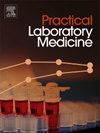Differential Distributions: A refined methodology to indirect reference interval estimation by including Patient's health status according to associated ICD-10 codes
IF 1.7
Q3 MEDICAL LABORATORY TECHNOLOGY
引用次数: 0
Abstract
Background
Traditional methods for estimating reference intervals (RIs) using patient's blood test results from the clinical routine, typically remove outliers without considering the nuanced health statuses of patients. This removes a vast majority of test results for reference interval estimation without considering the actual health status of the patient.
Methods
We introduce the Differential Distribution Method (DDM) which uses laboratory routine data coded with ICD-10 to approximate an underlying non-diseased age and sex stratified population from mixed clinical data. By removing test results that stem from subpopulations significantly different from the general population, reference intervals can be generated stratified by sex and age, taking into account the associated health conditions of the patients as derived by the ICD-10 coding system.
Results
Applying the DDM to blood plasma potassium levels demonstrated its ability to adjust RIs dynamically across different patient groups. The method effectively differentiated RIs in a decade-based stratification, showing significant variability and tighter confidence intervals, particularly in older (above 60 years old) adults. The RIs were slightly wider with advancing age in both males and females, while their standard deviation was reduced by removing large portions of test results differing significantly, grouped by either their individual ICD-10 code or clusters of ICD-10 codes.
Conclusions
This DDM data mining approach offers a robust framework for RI inference by generating adjusted RIs that incorporate clinical nuances reflected in ICD-10 codes. This approach not only enhances the accuracy of patient diagnostics but also facilitates the identification of potential multimorbidities affecting laboratory results.
差异分布:根据相关ICD-10代码,通过包括患者健康状况,对间接参考区间估计的改进方法
传统的参考区间(RIs)估算方法使用患者的临床常规血液检测结果,通常在没有考虑患者细微健康状况的情况下去除异常值。这就排除了绝大多数用于参考区间估计的测试结果,而没有考虑到患者的实际健康状况。方法采用差分分布法(DDM),利用ICD-10编码的实验室常规数据,从混合临床数据中近似出潜在的非患病年龄和性别分层人群。通过剔除来自与一般人群显著不同的亚群的检测结果,参考区间可以按性别和年龄分层生成,同时考虑到ICD-10编码系统导出的患者相关健康状况。结果将DDM应用于血浆钾水平显示其在不同患者组间动态调节RIs的能力。该方法在基于十年的分层中有效地区分了RIs,显示出显著的可变性和更紧密的置信区间,特别是在老年人(60岁以上)中。随着年龄的增长,男性和女性的RIs都略宽,而通过去除大部分显着差异的测试结果,将其按个体ICD-10代码或ICD-10代码簇分组,可以降低其标准偏差。这种DDM数据挖掘方法通过生成包含ICD-10代码中反映的临床细微差别的调整后的RI,为RI推断提供了一个强大的框架。这种方法不仅提高了患者诊断的准确性,而且有助于识别影响实验室结果的潜在多病。
本文章由计算机程序翻译,如有差异,请以英文原文为准。
求助全文
约1分钟内获得全文
求助全文
来源期刊

Practical Laboratory Medicine
Health Professions-Radiological and Ultrasound Technology
CiteScore
3.50
自引率
0.00%
发文量
40
审稿时长
7 weeks
期刊介绍:
Practical Laboratory Medicine is a high-quality, peer-reviewed, international open-access journal publishing original research, new methods and critical evaluations, case reports and short papers in the fields of clinical chemistry and laboratory medicine. The objective of the journal is to provide practical information of immediate relevance to workers in clinical laboratories. The primary scope of the journal covers clinical chemistry, hematology, molecular biology and genetics relevant to laboratory medicine, microbiology, immunology, therapeutic drug monitoring and toxicology, laboratory management and informatics. We welcome papers which describe critical evaluations of biomarkers and their role in the diagnosis and treatment of clinically significant disease, validation of commercial and in-house IVD methods, method comparisons, interference reports, the development of new reagents and reference materials, reference range studies and regulatory compliance reports. Manuscripts describing the development of new methods applicable to laboratory medicine (including point-of-care testing) are particularly encouraged, even if preliminary or small scale.
 求助内容:
求助内容: 应助结果提醒方式:
应助结果提醒方式:


